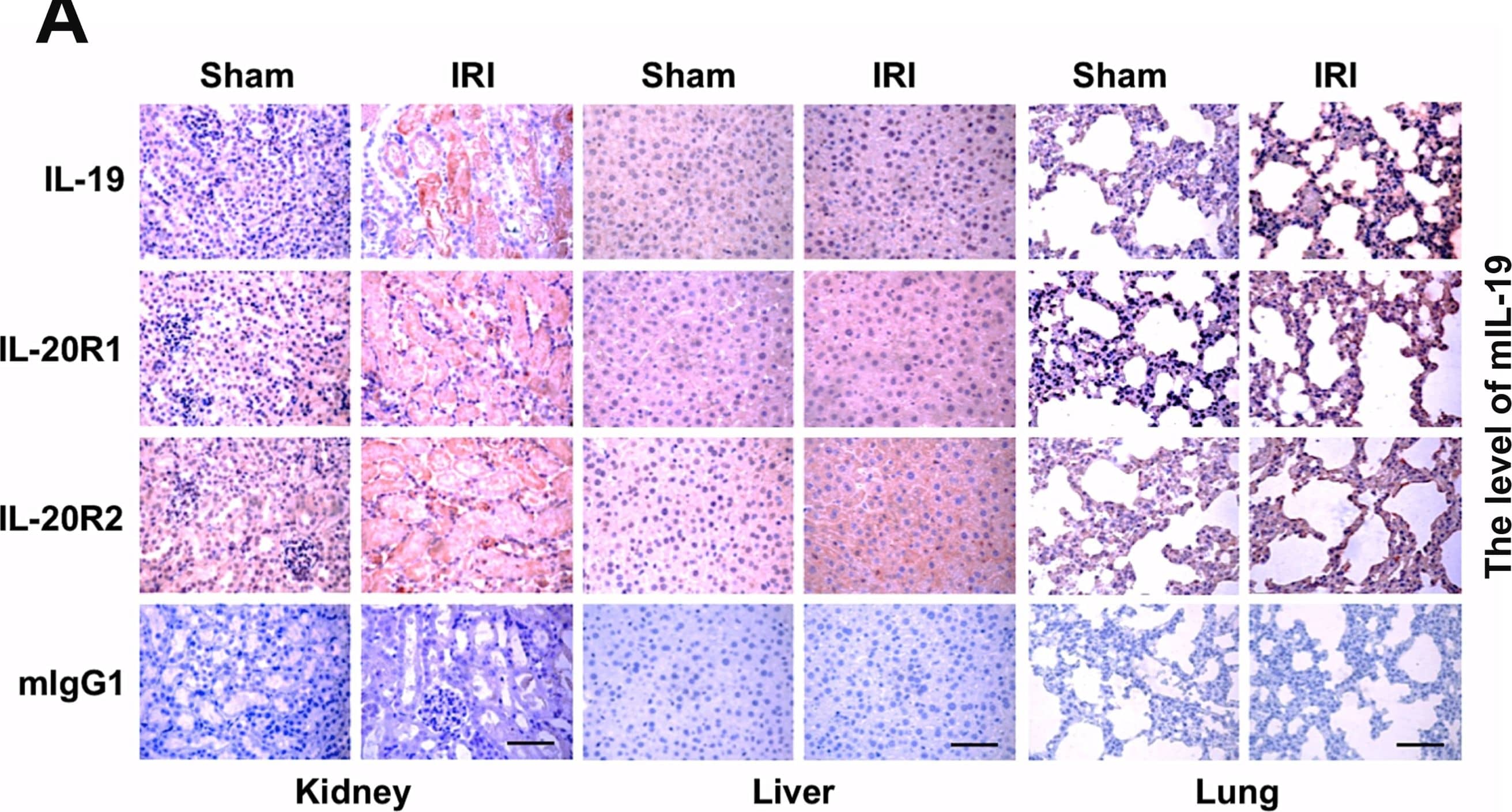Mouse IL-20 R beta Antibody Summary
Asp14-Asn215
Accession # NP_001032323
Applications
Please Note: Optimal dilutions should be determined by each laboratory for each application. General Protocols are available in the Technical Information section on our website.
Scientific Data
 View Larger
View Larger
Detection of IL‑20 R beta in bEnd.3 Mouse Cell Line by Flow Cytometry. bEnd.3 mouse endothelioma cell line was stained with Mouse IL-20 R beta Antigen Affinity-purified Polyclonal Antibody (Catalog # AF4388, filled histogram) or control antibody (Catalog # 5-001-A, open histogram), followed by NorthernLights™ 557-conjugated Anti-Sheep IgG Secondary Antibody (Catalog # NL010).
 View Larger
View Larger
Detection of Mouse IL-20 R beta/FNDC6 by Immunocytochemistry/Immunofluorescence Expression of IL-19 and its receptors in three vital organs of ischemic AKI mice.(A) AKI mice (n = 5 in each group) were killed 48 h after renal IRI. Paraffined sections of kidney, liver, and lung tissue were stained using anti-IL-19 mAb, anti-IL-20R1 mAb, and anti-IL-20R2 polyclonal Ab. Anti-mIgG1 was a negative control. The reaction was detected using AEC chromogen stain (red), and the nuclei were counterstained with hematoxylin (blue). The bars represent 50 µm. All five mice in each group showed similar patterns. Shown sections are representative of five individual mice. (B) Mouse tissues of each group (n = 5) were isolated and homogenized to extract total protein. Mouse IL-19 expression in kidney, liver, and lung were analyzed using direct ELISA. *P<0.05 compared with sham-operated mice. (C–E) Experimental mice were killed 2 days after renal IRI. RTQ-PCR was done with primers specific for IL-19, IL-20R1, and IL-20R2. The relative quantification of PCR products was expressed as 2− delta delta Ct, corrected using GAPDH expression, and relative to levels of untreated cells. Data are the means ± SD of three experiments. *P<0.05 compared with sham-operated mice. Image collected and cropped by CiteAb from the following publication (https://dx.plos.org/10.1371/journal.pone.0056028), licensed under a CC-BY license. Not internally tested by R&D Systems.
Reconstitution Calculator
Preparation and Storage
- 12 months from date of receipt, -20 to -70 °C as supplied.
- 1 month, 2 to 8 °C under sterile conditions after reconstitution.
- 6 months, -20 to -70 °C under sterile conditions after reconstitution.
Background: IL-20 R beta
IL-20 receptor beta (IL-20 R beta ), also known as IL-20 R2, is a type I transmembrane glycoprotein in the class II cytokine receptor family. These receptors are characterized by tandem fibronectin type III domains in their extracellular region and the lack of a WSXWS motif (1). Class II cytokine receptors form heterodimeric signaling receptor complexes that mediate class II cytokine signals. Subunits of the different receptor complexes are shared and serve multiple functions (1). Based on the structure of the human receptor, mouse IL-20 R beta should contain a 202 amino acid (aa) extracellular domain (ECD) with two fibronectin type III domains, a 16 aa transmembrane segment, and a 44 aa cytoplasmic domain (2). Within the ECD, mouse IL-20 R beta will share 81% aa sequence identity with human IL-20 R beta. It shares 18-29% aa sequence identity with the mouse class II cytokine receptors IFN-alpha R1, IFN-alpha R2, IFN-gamma R1, IFN-gamma R2, IL-10 R alpha, IL-10 R beta, IL-20 R alpha, IL-22BP, IL-22 R alpha, IL-28 R, and tissue factor. IL-20 R beta is generally expressed in psoriatic skin (keratinocytes and select endothelium), rheumatoid arthritis synovial membranes, and hepatocytes of LPS-treated mice, and it contributes to the local inflammatory reaction (3-6). IL-20 R beta heterodimerizes with IL-20 R alpha to form the receptor complex that mediates IL-19, IL-20, and IL-24 signals (3, 7-10). It also heterodimerizes with IL-22 R to form the functional receptor complex for IL-20 and IL-24 (7-9). Binding of these IL-10 family class II cytokines to their receptors induces activation of the JAK-STAT signal transduction pathway.
- Langer, J.A. et al. (2004) Cytokine Growth Factor Rev. 15:33.
- Accession # NP_001032323 and SwissProt # Q6UXL0.
- Blumberg, H. et al. (2001) Cell 104:9.
- Hsu, Y-H. et al. (2006) Arthritis Rheum. 54:2722.
- Wegenka, U.M. et al. (2007) J. Hepatol. 46:257.
- Chan, J.R. et al. (2006) J. Exp. Med. 203:2577.
- Parrish-Novak, J. et al. (2002) J. Biol. Chem. 277:47517.
- Dumoutier, L. et al. (2001) J. Immunol. 167:3545.
- Wang, M. et al. (2002) J. Biol. Chem. 277:7341.
- Pletnev, S. et al. (2003) Biochemistry 42:12617.
Product Datasheets
Citations for Mouse IL-20 R beta Antibody
R&D Systems personnel manually curate a database that contains references using R&D Systems products. The data collected includes not only links to publications in PubMed, but also provides information about sample types, species, and experimental conditions.
2
Citations: Showing 1 - 2
Filter your results:
Filter by:
-
Interleukin-20 targets podocytes and is upregulated in experimental murine diabetic nephropathy
Authors: YH Hsu, HH Li, JM Sung, WY Chen, YC Hou, YH Weng, WT Lai, CH Wu, MS Chang
Exp. Mol. Med., 2017-03-31;49(3):e310.
Species: Mouse
Sample Types: Whole Cells
Applications: ICC -
Interleukin-19 Mediates Tissue Damage in Murine Ischemic Acute Kidney Injury
Authors: Yu-Hsiang Hsu, Hsing-Hui Li, Junne-Ming Sung, Wei-Ting Chen, Ya-Chin Hou, Ming-Shi Chang
PLoS ONE
FAQs
No product specific FAQs exist for this product, however you may
View all Antibody FAQsReviews for Mouse IL-20 R beta Antibody
There are currently no reviews for this product. Be the first to review Mouse IL-20 R beta Antibody and earn rewards!
Have you used Mouse IL-20 R beta Antibody?
Submit a review and receive an Amazon gift card.
$25/€18/£15/$25CAN/¥75 Yuan/¥2500 Yen for a review with an image
$10/€7/£6/$10 CAD/¥70 Yuan/¥1110 Yen for a review without an image

